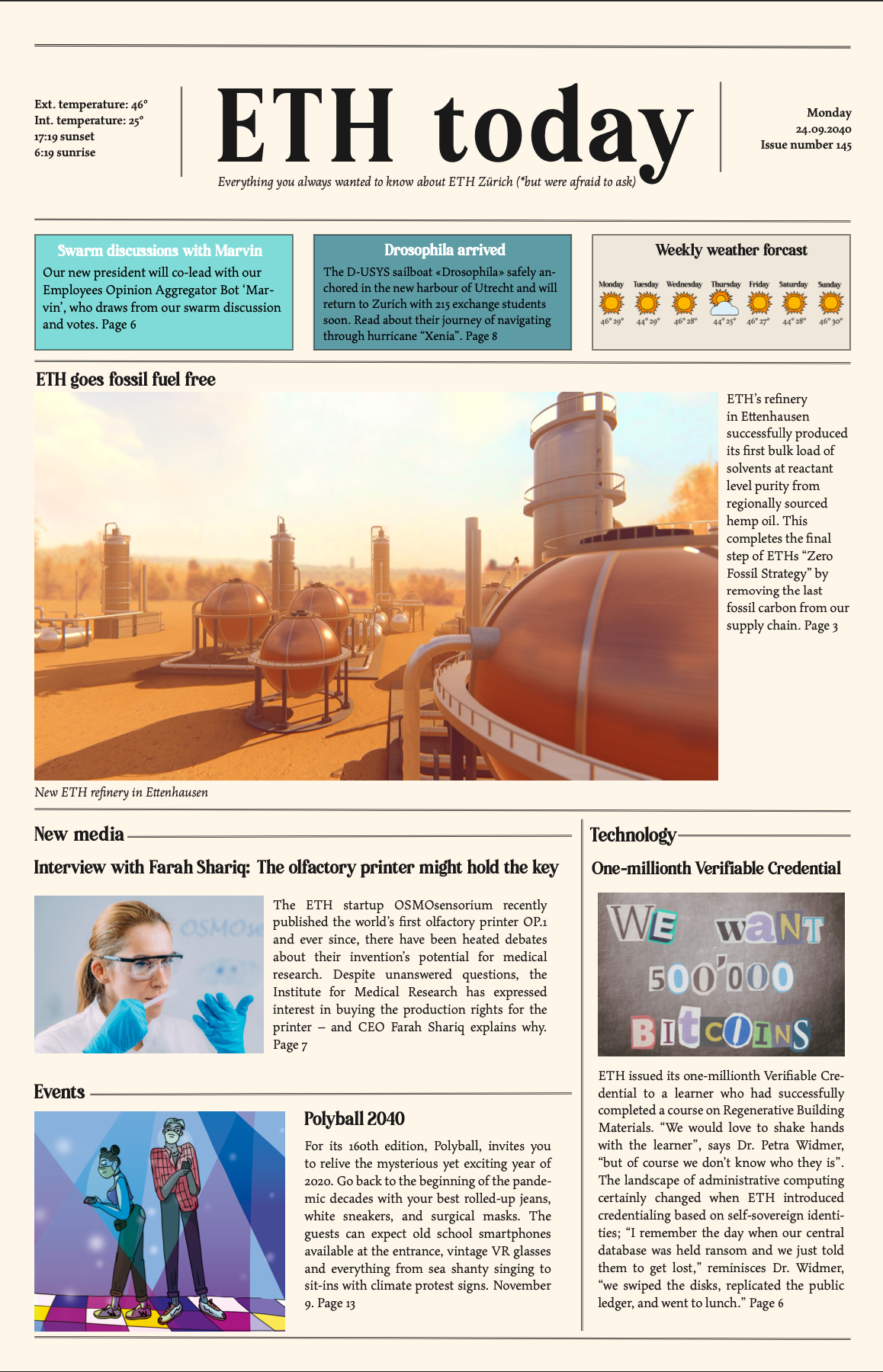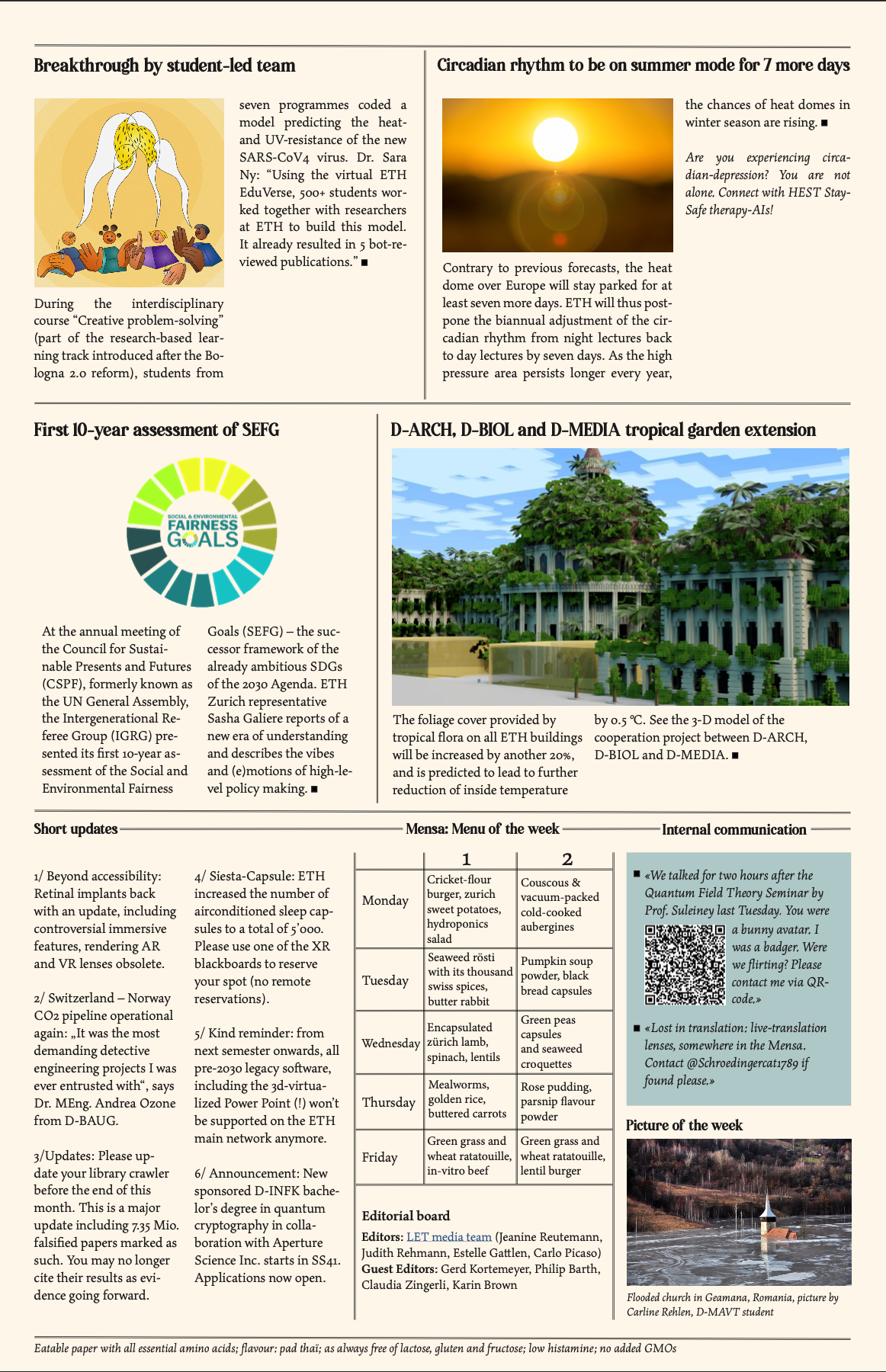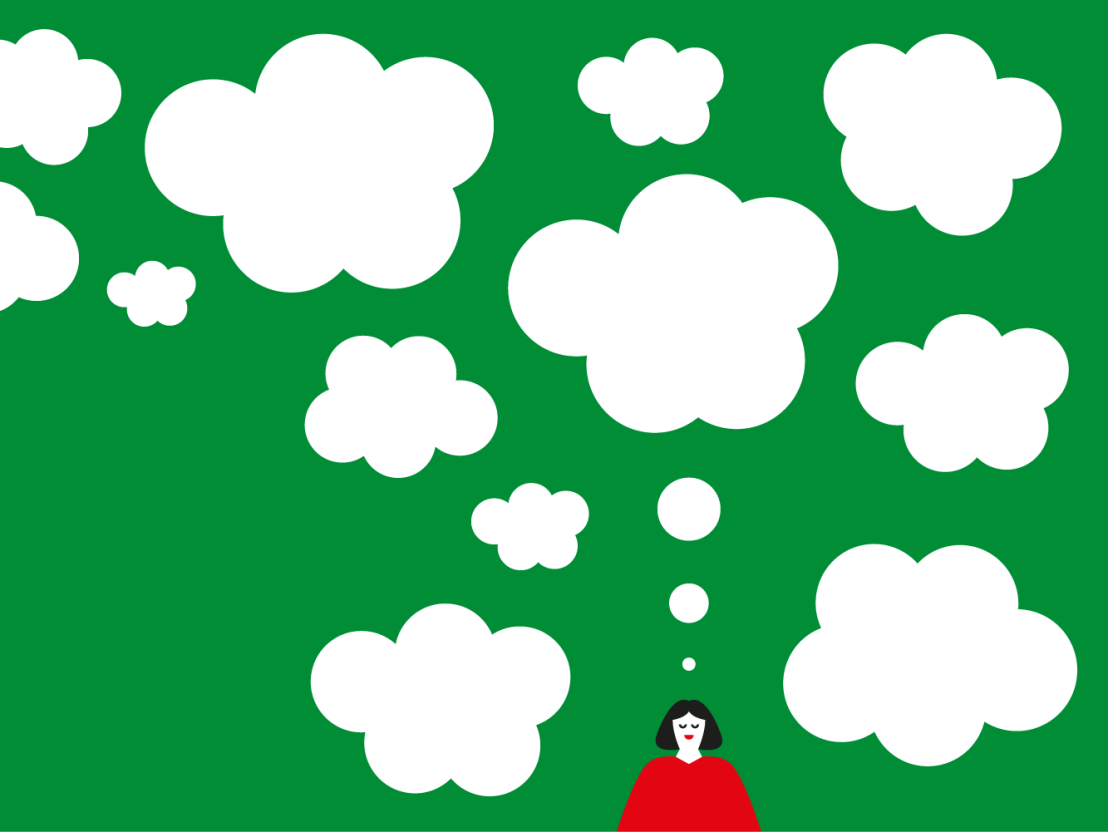2040 Essay Contest: Ausgewählte Essays 2022
In Spring 2022, the Strategic Foresight Hub invited the ETH community for the second time to travel to the year 2040 and describe everyday life in the future. Read the selected essays and vote for your favorite essay until 1 July!

Our time travelers shared visions of their everyday life at a hybrid university in the year 2040 in inspiring essays! The vivid descriptions included exciting ideas like:
- Students living in decentralized hubs
- AI-assisted degree programs
- 15-minute videos that replace traditional lectures
- Working and studying to go
- Hybridization of social and natural sciences
- Hybridization of all universities into a global university network
- Students meeting in virtual university worlds
- Lectures held at night due to high temperatures
- Assisting robots that can be controlled by one's own thoughts.
The SFH team selected four essays for public voting. Criterias for selection were relevance to the subject question, creativity, the underlying prospects, and reading flow.
Voting will continue until July 1.
The essay chosen by the public, as well as one chosen by SFH, will be further developed, analyzed using foresight methods, and published as a booklet.
Download Essay 1 (PDF, 42 KB)
Freedom of Choice
English translation
Lost in thought, I sit in the kitchen and watch my son eat an apple. Next year he'll be 20. How time flies, I'm tempted to say. It seems like yesterday he was taking his first steps with a cheeky smile. But then the turbulent years that lie behind us come to mind.
He was born in the middle of the corona pandemic. At the time, especially with a baby, it seemed like a privilege to work from home. How advanced it made us feel, all virtual and from a distance. Looking back, it seems almost primitive.
"Who are you working with today? " My son interrupts my thoughts. "I'm going up to Angelica, the farmer, who is often with us right now, to help her with the brones. Maybe she has the eye for how we can improve the buzzers," I reply.
The brones - our bee drones - that we developed in the collaborative at ETH did a good job, at least we had fresh food on the table more often again after years of worldwide famine. Still, they weren't perfect. They still showed a preference for certain flowers and plants. Discovering the cause of this in simulations was difficult. Perhaps the bright idea comes to us by doing work on the farm.
In my mind, I drifted back again. How much had changed. It would hardly have been conceivable for people to simply become part of ETH without a suitable degree.
Fortunately, things are different today. Everyone has understood that innovation can only develop to its full extent where diversity is lived. Theo comes to mind, who regularly stops by to work on the whirr of the brones. As a concert pianist, he has an ear for it, and his intermezzos at the grand piano in the atrium are a welcome pause for thought for many. I have to smile.
"What are you laughing to yourself for?" again my son snaps me into the present. "Oh. I needed to think about how nice it is to have a choice," I reply. "Are you going to your core group today?", I ask him. He has also been working at the ETH since he recently completed his compulsory learning period, and like everyone, he chooses his work two days a week freely. The rest of the time he grows brone-compatible flowers in the botanical garden.
"Neeh." He laughs. "I'm helping at the kindergarten at the center today. They're really excited about our new, colorful cultivation." I frown. Lately, on his flexible days, he's almost always there instead of the greenhouse. "Well, and Lara, she's really nice," he then adds.
So that's where the wind is blowing from. The kindergarten teacher, is perhaps more the reason than the enthusiasm of the little ones. "It's really nice to have the choice!", I say and wink at him, maybe I should present my work in the kindergarten soon and alongside get to know this Lara.
A little later I'm standing under the apple trees with Angelika. Our brones are humming around us, securing the next harvest. Angelika had spent her flexible work days with us in the group lately, after she had noticed that the brones approach the blossoms only shortly before wilting, which unfortunately reduced the yield of the harvest enormously.
We observe, puzzle and discuss for a long while what improvements we could make.
Next to us, Angelica's daughter plays with a ball and asks in between what we are talking about. When I explain to her that we don't understand why the brones don't see when the flowers are at their best, she laughs. She then closes her eyes, sticks her nose up in the air and takes a deep breath. They don't have to see, they have to smell, she then calls out and chases her ball.
Angelica and I look at each other and, aware that a little girl had just taken us a step further and that we would probably be studying odor sensors in the robotics lab next week, we start laughing.
Download Essay 2 (PDF, 48 KB)
A typical Wednesday in the life of a chemistry Professor in Singapore in 2040
Wednesday 12 October 2040, Singapore, around 8 am.
Maria is in her office at the university. It is located at level 2 and she has the privilege of having a window. Even if the window in tinted in blue to protect her from UV, she can still see the storms and lightnings that happen every other day or so.
Maria is sitting in her ergonomic soft organic chair, stretching her feet under the desk made of recycled wood and plastic, a tube of 3D printed solid coffee-vitamin D in hand. Today the tube has a drawing of a squirrel, to bring awareness about this endangered species. Maria needs her daily shot of vitamin D since she rarely goes outside as it is nearly impossible to breath with the combination of high temperature and high humidity. She is wearing casual smart wear, a beige ensemble made of kombucha fabric and a bamboo fiber dark pink jacket. Her hair is short and light brown. She had cut her hair a few years back to make a new handbag by the company Recyclair.
Deexiwala is Maria‘s office dipterobot, produced by the multinational company 10M. Deexiwala looks like a tropical tree from the diptercarp family with a human-like face in the middle of the trunk. Deexiwala stands proudly in the back corner of the office, its branches spreading through the ceiling and the walls to connect with the other dipterobots of the university and with the outdoor space too. Deexiwala purifies the air of Maria‘s office, distills water, but also records all data and information that is generated in Maria‘s office and laboratory. Deexiwala is also connected to GA which is the Grande Armillaria. The GA is the organic grid that connects all robots of all kinds using one single DNA-enhanced fungus from the Armillaria gallica species. Deexiwala was programed to talk with Maria‘s mother voice.
Maria (stretching) Deexiwala, what is my agenda for today?
Deexiwala (monotone voice) 9 am, lecture 6 to Seattle‘s students on biofuel synthesis by dragonflies at the hologram recording center.
Maria (still stretching) How do I go to HRC again?
Deexiwala (still monotone voice) From office, take lift to level B10. Take understreet 13 on the left until the aeration conduit Lee Boon Chan. Then, turn left to understreet highway A3. At the JEM undergate, take lift to level B5.
Maria (suddenly sitting up, looking at Deexiwala) Why not understreet 14?
Deexiwala (now speaking with intonation) Understreet 14 is under renovation. The ground temperature in this area has exceeded 40 degrees Celsius yesterday, leading to condensation in the aeration conduit Van Nam Pong and the entire understreet got flooded.
Maria Oh, ok. (short pause, licking her tube of solid coffee-vitamin D for a while then looking at the digital board that hangs on the wall.) And after HRC?
Deexiwala (bored voice) At 12 you are to take the Woofrail to the Daycare center for lunch and your daily child-parent bonding activity.
Maria Is it this week we go to the indoor park?
Deexiwala Today‘s activity is virtual walk through ancient Singapore, when temperature and humidity levels allowed to be outside during day time.
Maria (suddenly excited, stops licking) Great, I love this! And in the afternoon?
Deexiwala (speaking fast) 2 pm, making visuals for the Food on Mars grant. 5 pm: meeting PhD student Amoolyia. 6 pm, Woofrail to Daycare.
Maria (now scrolling through the digital board by making up and down gestures in the air.) Is Amoolyia coming to my office?
Deexiwala (normal voice) She said she preferred to meet in the lab so she can monitor her running experiment. Apparently, some locusts have an anti-social behavior which makes them increase the secretion of fuel.
Maria (still reading) And what was the latest value she got for the power generation with the locust-salmonella system?
Deexiwala 160 Wh per insect.
Maria (excited again) Not bad! Remind me to ask her to make predictions of how many insects we need for charging the Woofrail for a day.
Maria quickly stands up, takes her handbag and exits the room in a rush.
Download Essay 4 (PDF, 41 KB)
Hybrid
English translation
It's 7:30 a.m. in the morning, my alarm clock is ringing. Like most days the daily routine ensures that I'm awake a few minutes before it rings. Still, I wait until the alarm goes off. On principle. It's Wednesday, so half of the week is almost done. I decide to have breakfast outside in the park in this beautiful weather. At the buffet I meet Francesco and Aleen, who had the same idea. Francesco grew up in Switzerland like me, but in the Italian-speaking part, and is now studying mechanical engineering with me in the 3rd semester at the ETH, at the location on the Portuguese coast. Aleen, on the other hand, grew up in London and is now enrolled at an English university. The fact that we can be here together is thanks to a fundamental change in university teaching called "Hybrid University". Hybrid is the teaching of theory, which takes place almost exclusively digitally and is combined with practical research and on-site exercises. This means more research time for teachers, and it made it possible to open second ETH locations outside of Zurich and Switzerland. Now, research is no longer done where the campus is located, but the campus is located where research can be done. I am very interested in solar energy use, which is why I chose the research site in Portugal, where research is being done on carbon capture processes and solar seawater desalination, among many other things.
A similar concept to the hybrid university has been implemented at other universities. The local site is therefore also run by other universities, the reason why Aleen is here. This allows networking within Europe and the combining of different approaches.
The hybrid university brought advantages to everyone. For the professors it means more research time, for the students a more flexible learning arrangement, thus higher efficiency, and more time for other things. For the ETH it means more international students because of the good research conditions at multiple locations and for the Swiss economy an even better international network of researchers.
After breakfast we go to the learning areas in the park. Here it is a bit cooler (in temperature) than in the rest of the campus. Starting at 10 am Francesco and I have a practice lesson until noon, until then we can watch theory videos. There are three different videos for each topic, which vary in detail level, so you don't waste time with things you already understood, but, if necessary, you can get the required explanations.
During midday it is usually very hot. In the park and in the buildings, it is bearable, but the combination of sun and lunch do not make it easy to concentrate, so we usually take a nap. In the afternoon we meet with our project group. You can either work on the "big" research projects, the ones because of which the location was chosen here, or submit project ideas yourself. I chose to work on the seawater desalination project, where five of us in our project group are now working on improving the coarse filter cleaning system. I really appreciate that we are both internationally mixed in this group and that we work together across different ages. This way, I can benefit from older master students, and they can gain experience in team leadership.
Afterwards, I go into the evening break relatively early. Together with my friends we go out for dinner and sometimes we play another round of volleyball. While many people end the day this way and get up a little earlier the next morning, I prefer to use the cool evening hours to solve a few more exercises.



